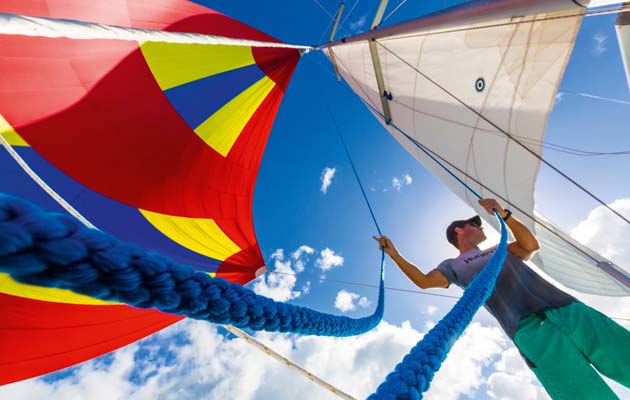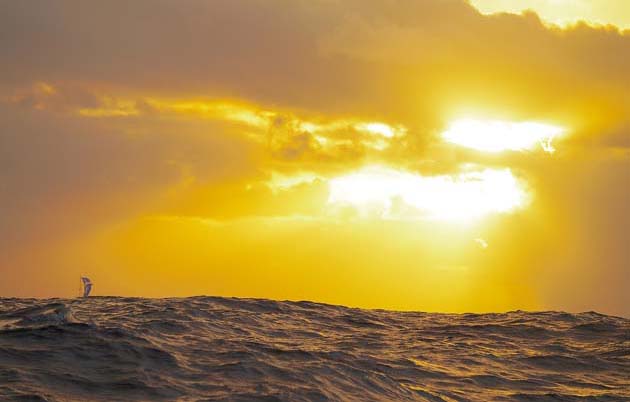If you can’t yet give up work, how do you escape to sail to the Caribbean? Elaine Bunting talked to ARC sailors doing just that
Do you really need to stop work or take months off to make a transatlantic crossing? What if you can’t quit, or you don’t have the funds for your own boat?
You can still do it, and each year scores of people manage to fit in a ‘time poor’ ARC transatlantic rally, sometimes as a starter experience to help with planning a bigger adventure later on.
At almost every stage of life prior to retirement, from teens and early twenties to empty nesters, people have found a way. At this year’s ARC we spoke to some of the crews who had managed to squeeze an ocean crossing ambition into a few weeks or months away from work or between jobs.
One means of managing it is to sail one way and ship your boat back to Europe, and a growing proportion of ARC sailors do exactly that. The choice of routes from the Caribbean and US East Coast with companies such as Sevenstar and Peters & May has made it an attractive option, and may not cost much more than a delivery, when flights and wear and tear are taken into account. The less obvious knock-on of this option is that many owners are choosing yachts for a ‘downhill only’ voyage.
“It’s my feeling that people are buying comfortable, light, what I call marina boats,” says World Cruising’s communications director, Jeremy Wyatt. “They are not hardcore bluewater boats as people are more ready to ship back. It’s not that you can’t sail these boats across oceans – you can – but you need to bear in mind their performance envelope and limitations because the sailing is relatively harder on the way back. So, stress [on the boat] and time poverty are the factors.”

Weather forecaster Chris Tibbs delivers a weather and routeing seminar to skippers
Despite having the smallest yacht in the fleet, Pierre-Yves Luxey’s Pogo 30, Avel Biz, is well-found and seaworthy, and he has both shipped back to Europe and, with more time to spare, returned under sail via the Azores.
Luxey, 61, is a doctor in emergency medicine and not yet retired so he has limited time for sailing. But he is still managing to cross the Atlantic again this year and will take a family cruise aboard in the Caribbean. He thinks he’s found an ideal balance, helped by having this small, simple, quick boat. We say: “petit bateau, petits problèmes,” he laughs.
Luxey took a week in October to sail Avel Biz down to the Canary Islands before returning to work in France and had another month away from mid-November to mid-December to sail across the Atlantic with the ARC. His boat will stay in the Caribbean until March, when he’ll take another two weeks off to come back out with his family. So for seven or eight weeks away from work in six months, he’s helped himself to a capsule Caribbean adventure.
If the boat is shipped back, he can switch straight over to Mediterranean sailing for the summer.
Over the winter and for some of the next summer, his boat will pay its own way. He has listed Avel Biz with a charter company and it will be rented out for €1,500 a week, of which he receives €700.
“The rental will pay my ARC fee and costs,” he says. “I’ve done this for four years since the boat was new, and it is rented for about 90 days a year. The boat is easy to charter. It’s easy to sail, and to sail fast – everything is light, the winches are tiny.
“People’s eyes light up when they see they can sail at 10-12 knots with the family and with no effort and I just call the company when I’m coming out and the boat is clean and prepared. For me, it’s a good solution. And my boat is cheap compared to many complicated boats. The standard price is €100,000 – I paid €130,000 with everything added – and so that is affordable.”

There are many families in the rally, usually grouped together on the same pontoon
But what do you do if you don’t own a yacht, don’t want to buy one yet – or maybe never do, but would like to tick off an Atlantic crossing? The buy-a-berth ‘pay to play’ options are plentiful in the ARC, but it’s not cheap: the going rate is around €5,000. Crews who pay to go across are usually after a specific set of learning experiences and tutoring from a professional skipper.
Charter company Girls for Sail have sold ten paying berths on their Beneteau 40.7.
The crew who have signed up with this company tell me they want to learn as much as possible in the six weeks they’ve taken off for the ARC and have chosen this women-only company partly to be sure they won’t be relegated to ‘female’ roles.
Naomi Butterworth is self-employed. “It was buying a house or doing this,” she says. “I’ve just turned 30 and all my friends are having babies. I wanted to do this as a personal challenge.” She is using the event to raise funds for charity.
Josie Steel, a clinical psychologist, is on a year out between placements, during which she has cycled across Europe and been scuba diving. This is “a final challenge” before going back to work.
“I didn’t want to be with a male crew, I was looking for a female crew and a commercial boat because safety and instruction is important to me,” she explains.
Silvia Specht, a psychologist, management coach and mother of two from Buenos Aires, is a more experienced sailor who has covered over 8,000 miles and wanted a berth on a yacht that was not going to cancel because of maintenance issues or the skipper’s other commitments. “This way, you’re sure you’re going to go,” she says.

ARC 2017 start out of Las Palmas
Continues below…
30 expert tips for crossing the Atlantic – from checking the sails to choosing crew
1. Keep the downwind sailplan simple What’s the best sail configuration for a downwind crossing? Actually, the chances are you…
What downwind sails should you have for an Atlantic crossing?
What downwind sails should you buy for an Atlantic crossing or cruising beyond the Caribbean? This is one of the…
Ocean-bound – experienced skippers offer their advice on ARC preparation
As this year marks the 30th running of the Atlantic Rally for Cruisers (ARC), which Yachting World helped set up…
For her, too, Girls for Sail’s female-only ethos is a selling point. “It is less competitive in a certain way and you’re not afraid to ask a stupid question. And with the people we have, you’re looking at some of the features of typical high performance teams. Our motivation to make it a good time is high.”
Most of this crew had yet to spend a night at sea, and had never met before. Perhaps because of this they were expecting a challenge rather than a dream holiday – that outlook is more common on larger, luxurious cruisers, and can sometimes lead to a disappointing mismatch of expectation and reality.
“There will be good days and bad days but new experiences all the way through, and maybe it will help us experience things we take for granted. I’m sure we’ll laugh a lot and rely on each other,” says Naomi Butterworth.
If you’re very lucky, you might get a chance to sail with your parents, or be able to give that opportunity to teenage or young adult children. The youngest skipper this year was 18-year-old Louie Neocleous, sailing his father’s Beneteau Oceanis 55 with his dad and some friends (average age on board was 25). Neocleous left school at 16 with the intention of making a living at sea.
“I’ve been sailing full-time since, helping my dad, who was a motorboater, get this [new] boat ready, taking courses and doing two seasons of RORC races and the Fastnet,” says Neocleous. For someone still a teenager, he comes across as remarkably poised and mature.
“My dad owns a construction company and I had an option to go into that. He has made quite a bit of money from it, but he said to me he’d never really enjoyed it and he recommended I did something I’d enjoy. My goal would be to become a Master Mariner.”
If you’re not fortunate enough to sail on someone else’s boat and you don’t want to wait for the financial fruits of middle age, let alone retirement, what are the options? How about working for a few years and pooling funds for a barefoot adventure with likeminded friends?

Some of the crew of Swedish yacht Aloha – ARC 2017 – Las Palmas
William Malmsten, 23, sailed on the ARC two years ago and was taken with the idea of living on his own boat. Malmsten is a carpenter. On returning home to Nynäshamn, 60km south of Stockholm, he threw himself into house building work, saving as much money as he could. He clubbed together with two lifelong friends, electricians Jonathan Castell and Max Ericson, to buy a 1992-build Sirena 44 lying in Denmark. They paid €72,000. “It was a good price and it had a new rig and engine,” he says.
The three spent months equipping Aloha to bring her up to spec for ocean sailing. They installed solar panels, new batteries, watermaker, electrics and nav system – €30,000 of extras. Now they are crossing the Atlantic bound for the Pacific and beyond.
“We’ll see how it goes,” says Malmsten. “We’ve sold everything – cars, apartments. All we’ve left at home are our girlfriends.”







